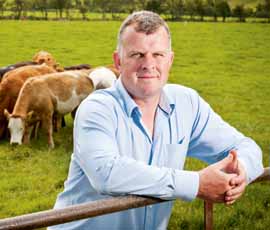2011 FW Awards winner: Beef Farmer

Sam Chesney
Cool Brae Farm, Kircubbin, Northern Ireland
Winning ways
• Impressive focus on maximising efficiency
• Good grassland management
• Excellent production figures
If only bankers were on top of financial and performance figures in the same way as beef farmer Sam Chesney, then maybe they wouldn’t be in such turmoil, joked one of the judges after visiting his farm.
His impressive attention to every single aspect of his business – using accurate data, costs and benchmarking to guide how to adapt his production system or invest on inputs – marks Sam out as winner.
This focus has enabled him to adjust and conquer rising input prices, securing a profit in a country where beef producers are losing £400/cow on average. Having no control over the price of beef has forced Sam to explore every “efficiency” angle. This includes better forage quality to allow him to significantly reduce the amount of meal fed to his 120 Limousin cross suckler cows, as well as tackling herd health by having a health plan and vaccination policy in place.
Sam has focused on high herd health, grassland management and good genetics. He breeds Limousin cross cows, served to Limousin and British Blue bulls, which gives him an option of finishing animals for beef or selling them as stores and replacement suckler heifers. He has also incorporated Aberdeen Angus into the herd as there is a “buzz” for Aberdeen Angus crosses in Northern Ireland.
And the production figures speak for themselves. The herd is spring calving, with a growth rate target of 1kg a day for heifers and 1.4kg for bulls. Heifers are calved at 24 months, with an estimated breeding weight of 385kg at 13 months of age and a calving index of 353 days for heifers and 338 days for second calvers – way above the 400-day average in Northern Ireland.
“It costs £1.50 not getting a cow in calf every 350 days, which equates to £75 a cow over 50 days,” says Sam.
Sam’s rationale is to run his beef enterprise like a dairy unit. His grassland management is like that of a dairyman, with strip grazing broken up by 48 miles of electric fences and a computer package used to indicate just how many grazing days he can get from each specific paddock.
“The drive is to get the maximum from every acre. It only costs 16p/kg liveweight to finish an animal off grass – there’s no room for poor grassland management here,” says Sam.
Health is also a top priority, with cows vaccinated for leptospirosis, blood profiled eight weeks prior to calving and then fed diets to suit mineral deficiencies. This has enabled him to stop annual vitamin E injections and include iodine in the water.
Each calf is also bolussed with probiotics and given one tablet for scours. This has almost eliminated scours and pneumonia is rarely a problem either due to the vaccination programme in place and good ventilation.
As a director of Strangford Down co-operative and also a DARD Focus Farmer, he shares his knowledge to help others improve their businesses, often opening his farm up for tours. “I also learn a lot from other farmers, particularly when I host farm walks.”
Farm facts
• 120 Limousin sucklers mated to British Blue and Aberdeen Angus
• Heifers breed at 24 months
• Member of Strangford Down co-operative
 Sponsor’s View
Sponsor’s View
As one of the UK’s largest purchasers of British beef, we are committed to ensuring it has a sustainable future. For the seventh consecutive year, we are proud to be sponsoring the Farmers Weekly Beef Farmer of the Year award because it truly recognises the best the UK has to offer
Brian Mullens, Senior Vice-President
